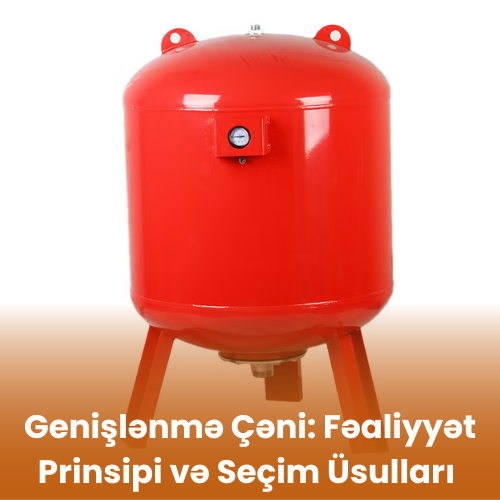Expansion Tank: Operating Principle and Selection Methods

What is an Expansion Tank?
An expansion tank is a component used in heating and water supply systems to control changes in water volume. When the water expands due to heating, the expansion tank absorbs the excess volume, ensuring that the pressure in the system remains at a safe level.
How Does an Expansion Tank Work?
The expansion tank mainly consists of two sections: one side contains water, while the other side holds air or gas (usually nitrogen). Inside the tank, there is an elastic membrane or diaphragm that separates the water and air, balancing the pressure when water expands.
Advantages of an Expansion Tank
• Maintains stable pressure in the system, prolonging the lifespan of pipes and pumps.
• Regulates water flow and prevents frequent pump operation.
• Enhances the safety of heating systems by minimizing the risk of boiling and explosion.
Where Are Expansion Tanks Used?
• Central heating systems (boiler rooms, radiator systems)
• Water supply systems (hydrophore systems)
• Hot water supply and solar energy systems
The correct selection of an expansion tank depends on its capacity, the operating pressure of the system, and the temperature of the water used.
Types of Expansion Tanks
Expansion tanks are classified based on their application and internal structure. The main types include:
1. Open-Type Expansion Tank
• Open to the atmosphere, allowing free expansion of water volume.
• Commonly used in older heating systems.
• Requires maintenance, as water evaporation necessitates regular refilling.
2. Closed-Type Expansion Tank
• Has a hermetically sealed structure with an elastic membrane or diaphragm between the water and gas.
• More secure and efficient, as it automatically regulates system pressure.
• Widely used in modern heating and water supply systems.
Closed-type expansion tanks are divided into two subtypes:
✔ Membrane Expansion Tank – Contains an elastic membrane that separates the water from the gas chamber. As pressure increases, the membrane expands, compressing the gas.
✔ Tanks where air is in direct contact with water – These do not have a separating membrane, but over time, gas dissolves in the water, leading to pressure loss.
3. Hydrophore (Water Supply) Expansion Tank
• Used in combination with water pumps.
• Helps maintain stable pressure in the system, reducing pump operation and saving energy.
• Contains a rubber bladder or membrane that separates the water and air.
4. Expansion Tank for Solar Energy Systems
• Used in solar water heating systems.
• Designed to withstand temperature fluctuations caused by solar energy.
Installation of an Expansion Tank
1. Choosing the Right Location
• For heating systems, the expansion tank is usually installed in the boiler room, at the highest point of the system, or on the return line.
• For water supply systems, the tank should be placed near the pump.
2. Installation Steps
For Open-Type Expansion Tanks
✔ Must be installed at the highest point of the system (e.g., in the attic).
✔ Ventilation should be ensured for proper air release.
✔ Should be protected with insulation to prevent water from freezing.
For Closed-Type (Membrane) Expansion Tanks
✔ Should be connected to the main pipeline where water circulates.
✔ Must include appropriate valves and a pressure gauge for monitoring.
✔ The tank’s pressure should be adjusted according to the system's working pressure.
✔ Should be securely mounted to the wall or floor.
For Hydrophore Expansion Tanks
✔ Must be connected to the pump’s outlet line.
✔ A pressure regulator should be used to ensure system stability.
✔ In membrane models, air pressure should be checked regularly.
3. Important Considerations During Installation
✅ The tank’s volume and pressure should match the system’s requirements.
✅ All pipe connections must be secure and leak-proof.
✅ A safety valve and air vent should be installed to prevent excessive pressure buildup.
✅ The temperature in the area where the expansion tank is installed should remain stable.
4. Maintenance and Inspection
🔹 Pressure in membrane tanks should be checked at least once a year.
🔹 In open-type tanks, the water level should be regularly inspected and refilled if necessary.
🔹 All pipe connections should be monitored for leaks.
Frequently Asked Questions About Expansion Tanks
1. What is the purpose of an expansion tank?
✅ An expansion tank regulates pressure caused by water expansion in heating and water supply systems. This prevents damage to pipes and reduces the frequency of pump operation.
2. What happens if there is no expansion tank?
✅ In heating systems, without an expansion tank, pressure increases due to water expansion, leading to leaks or potential system failures. In water supply systems, the pump may operate more frequently, wearing out faster.
3. What is the difference between open and closed expansion tanks?
✅ Open-type expansion tanks are installed at the highest point of the system and are open to the atmosphere. Closed-type tanks have a membrane or diaphragm to maintain stable pressure, making them safer and more efficient.
4. How is the volume of an expansion tank calculated?
✅ The tank's volume should be 10-15% of the total water volume in the system. For example, if the heating system contains 100 liters of water, the expansion tank should have a capacity of at least 10-15 liters.
5. What pressure should an expansion tank operate at?
✅ The pressure of a closed-type expansion tank should be 0.2-0.3 bar lower than the system’s operating pressure. For example, if the heating system operates at 2 bar, the expansion tank should be set to 1.7-1.8 bar.
